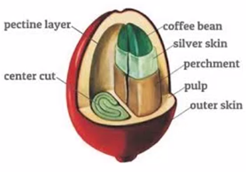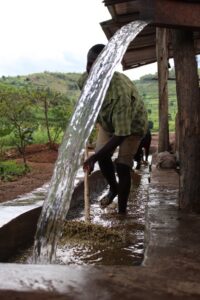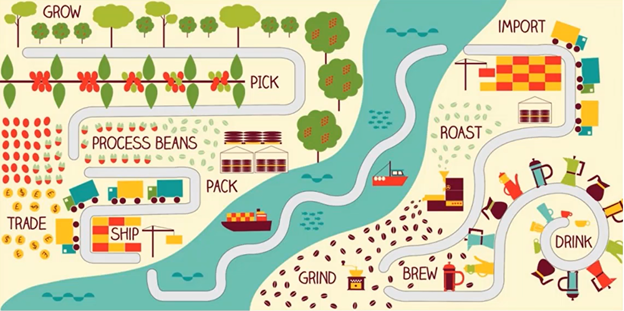In the vast expanse of tropical climates between The Tropic of Cancer and The Tropic of Capricorn is the Coffee Belt, where the process of coffee cultivation begins. In part one of our new Coffee University series, we delve into the intricate process of transforming coffee cherries into the drink filling our cups every morning.
The origin of coffee beans
 The heart of coffee lies within its beans, extracted from the cherries which flourish on coffee trees.Typically, each cherry yields two beans. Within the coffee world, there are two major species – Arabica and Robusta. Robusta, derived from multi-stem trees at lower elevations is known for its bitterness and finds its place in traditional or value coffees. In contrast, the shrub-like Arabica, cultivated at higher elevations offers a premium coffee experience due to the thinner air which fosters slower maturation.
The heart of coffee lies within its beans, extracted from the cherries which flourish on coffee trees.Typically, each cherry yields two beans. Within the coffee world, there are two major species – Arabica and Robusta. Robusta, derived from multi-stem trees at lower elevations is known for its bitterness and finds its place in traditional or value coffees. In contrast, the shrub-like Arabica, cultivated at higher elevations offers a premium coffee experience due to the thinner air which fosters slower maturation.
Harvesting methods
Mechanical picking, a cost-effective approach, is the main method of harvesting robusta beans, although it results in cherries being picked regardless of ripeness. On the other hand, the majority of Arabica beans are meticulously picked by hand, ensuring a selection of only the ripest cherries.
 Processing the beans
Processing the beans
The journey continues with the meticulous washing of coffee beans. The Wet Method uses water to cleanse cherries before a depulping machine separates the bean from the cherry. In contrast, the Natural Method, predominantly used for robusta, involves sun-drying cherries on patios, followed by hulling with a peeling machine.
Roasting magic
Coffee beans are subjected to high temperatures, triggering the evaporation of moisture and release of aromatic oils. The sugars within the beans caramelize, highlighting the coffee with its distinct flavor and color. The duration and temperature of roasting are tailored to the origin of the beans.
Decaf and flavored varieties
For those looking for an option without caffeine, decaf coffee undergoes a meticulous process where at least 97% of caffeine is removed. Flavored coffee, typically crafted from 100% washed Arabica beans, is an artful blend which enhances, rather than masks, the natural coffee flavors. Only the finest ingredients are added to ensure a premium taste.
Preserving freshness
Post-roasting, coffee beans emit CO2 for a limited time. Packaging equipped with one-way valves allows the escape of CO2 while preventing the entry of oxygen, safeguarding the beans against staleness. Exposure to air and moisture can accelerate the deterioration process, emphasizing the importance of proper storage.
The journey from tree to cup is a compilation of nature, craftsmanship and dedication, culminating in the beverage that many of us and our customers enjoy daily. Stay tuned as Coffee University unravels more secrets brewing behind each sip.
